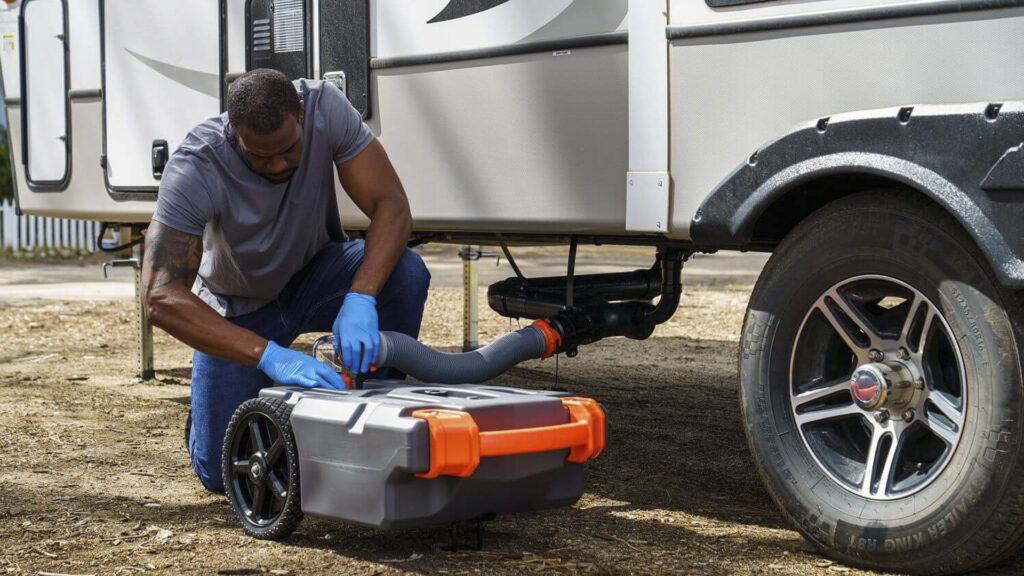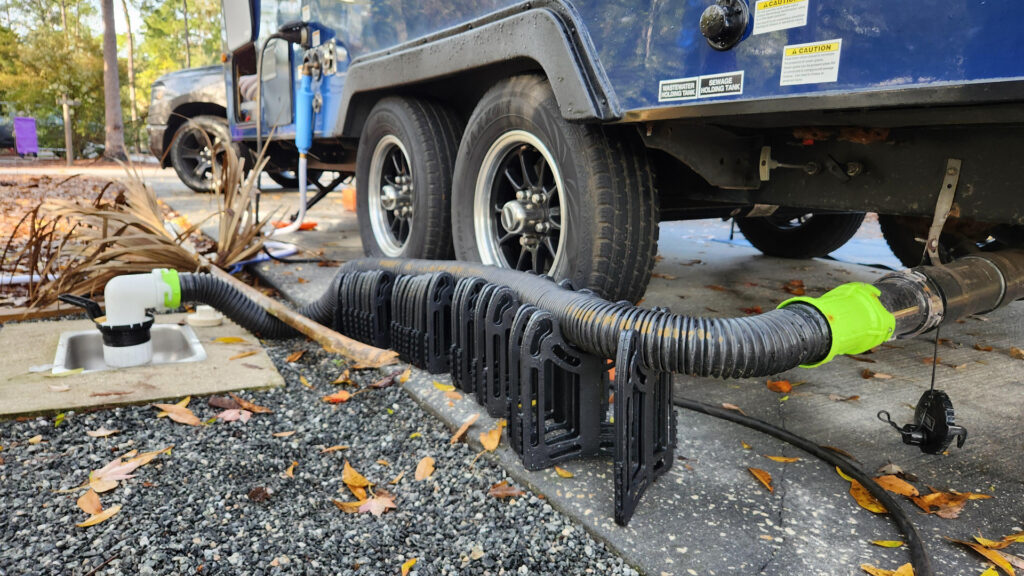Table of contents
- What Are Holding Tanks and Septic Tanks?
- Key Difference #1: Purpose and Function
- Key Difference #2: Physical Characteristics and Design
- Key Difference #3: Installation Costs
- Key Difference #4: Maintenance Requirements and Costs
- Key Difference #5: Permit Requirements and Regulations
- Key Difference #6: Ideal Usage Scenarios
- Making Your Decision: Factors to Consider
- Related Articles
Proper wastewater management is crucial for any property without access to municipal sewer systems, and when it comes to managing wastewater, RV owners often face the decision of choosing between a holding tank and a septic tank. Whether you are living in your RV full-time, have a seasonal setup, or use your RV for occasional camping, knowing the differences between these two systems can help you make the best decision for your needs. So, what is a holding tank, and how does it differ from a septic system? In this article, we will explore the key differences between holding tanks vs septic tanks, focusing on their purpose, design, installation costs, maintenance requirements, and ideal usage scenarios. Approximately 21 million US households rely on septic systems for wastewater treatment, but in some cases, holding tanks are necessary. Let’s dive into understanding the essentials of these systems to help you make an informed decision.
What Are Holding Tanks and Septic Tanks?
Holding Tank Basics
A holding tank is a watertight container designed solely to store wastewater. It collects all household wastewater from your RV, including sewage, gray water, and other waste, without treating it. Holding tanks do not process or treat the wastewater; instead, they temporarily store the waste until it is pumped out. They typically have one compartment and an access lid for easy pumping.
Common materials used for holding tanks include polyethylene, fiberglass, and concrete. These tanks come in various sizes, typically ranging from 500 to 2,000 gallons, to accommodate different usage needs. Holding tanks usually come equipped with a high-level float alarm, which alerts you when the tank is nearly full and needs to be pumped out.
Septic Tank Basics
A septic tank, on the other hand, is part of a complete wastewater treatment system that not only stores but also processes waste on-site. Septic systems separate wastewater into three layers: scum (floating solids), effluent (liquid waste), and sludge (solid waste). The solid waste settles at the bottom, while bacteria break down organic matter, helping to treat the wastewater.
A septic tank usually consists of two compartments, and it has access ports for regular inspection and maintenance. Septic systems work in conjunction with a drain field, where the effluent is filtered and absorbed into the soil. Septic systems are designed for long-term, sustainable wastewater management with minimal intervention. Sizes generally range from 500 to 2,000 gallons, depending on the needs of the property.
Key Difference #1: Purpose and Function
How Holding Tanks Function
Holding tanks serve as temporary storage containers for wastewater. They don’t treat or process waste in any way. All waste is stored in the tank until it is pumped out by a professional service. Holding tanks have no outlet, meaning they do not release wastewater into the surrounding soil, unlike septic systems. They function purely as storage and require frequent emptying, depending on usage.
How Septic Tanks Function
In contrast, septic tanks are designed to treat wastewater on-site. They perform a separation process with three layers: scum, effluent, and sludge. The effluent is filtered through soil in the drain field to remove any remaining contaminants. Beneficial bacteria break down organic waste in the tank, providing a treatment process that requires little intervention over time.
Key Difference #2: Physical Characteristics and Design

Holding Tank Design Features
Holding tanks have a simple, single-compartment design. They are often made of materials like polyethylene, fiberglass, or concrete and are available in various sizes. Since holding tanks only store waste, they do not have an outlet pipe. Instead, all waste remains inside the tank until it is pumped out. The design includes a high-level alarm system to notify homeowners when the tank is nearing capacity, allowing timely intervention before overflow.
Septic Tank Design Features
Septic tanks have a more complex design. Typically made of concrete, fiberglass, or polyethylene, septic tanks contain two compartments and multiple access lids for maintenance. They include internal baffles to separate solids from liquids and pipes that allow wastewater to flow through the system. Septic tanks are equipped with a drain field to filter effluent and return the treated liquid into the ground.
Key Difference #3: Installation Costs
Holding Tank Installation Expenses
Installing a holding tank is generally less expensive than installing a septic system. The installation of a holding tank typically costs between $6,500 and $8,000, depending on factors like tank size, material, and site preparation. Although the initial investment is lower, it’s important to consider the long-term maintenance and pumping costs when evaluating the overall cost of using a holding tank.
Septic System Installation Expenses
In contrast, installing a septic system is more expensive, with costs typically ranging between $12,500 and $22,000. The higher cost is due to the more complex system, which includes a tank, drain field, piping, permits, and labor. While the upfront installation costs are higher, septic systems usually incur lower maintenance costs in the long run, making them more cost-efficient for properties that will use the system permanently.
Key Difference #4: Maintenance Requirements and Costs
Holding Tank Maintenance
Holding tanks require regular pumping to remove wastewater, and depending on usage, the tank may need to be pumped out every 2-4 weeks. The average cost per pump-out is about $560, which means the annual cost for frequent pumping can total around $6,720. While holding tanks have minimal maintenance beyond pumping, the frequency and cost of these services can add up quickly. Homeowners need to monitor the tank levels and respond promptly to alarms to avoid overflows.
Septic Tank Maintenance
Septic tanks, on the other hand, have a longer pumping interval, typically every 3-5 years. The average cost for a septic tank pump-out is about $375, leading to an annualized cost of approximately $125. In addition to pumping, septic tanks require periodic inspections and drain field care. Practices like water conservation and avoiding harmful chemicals can help prolong the system’s life.
Key Difference #5: Permit Requirements and Regulations
Holding Tank Permits and Regulations
The use of holding tanks is subject to more stringent regulations in many areas. Local jurisdictions may only allow holding tanks in specific circumstances, such as properties with unsuitable soil conditions. Common regulations may include the requirement for a service contract, pumping logs, and alarm systems. Always check local regulations before installing a holding tank to ensure compliance.
Septic System Permits and Regulations
Septic systems are also regulated, but their permitting process typically involves soil testing, system design approval, and installation inspections. In some areas, ongoing compliance is required, including periodic inspections or maintenance reports. It’s crucial to work with local authorities to ensure that the septic system meets all regulatory requirements.
Key Difference #6: Ideal Usage Scenarios
When to Choose a Holding Tank
A holding tank is ideal in situations where the soil is unsuitable for a drain field, or space limitations prevent the installation of a septic system. Holding tanks are perfect for seasonal or vacation properties, temporary construction sites, or areas with high water tables or proximity to water bodies. If you have a small lot with limited space, a holding tank may be the best solution.
When to Choose a Septic System
A septic system is preferable for permanent residences with suitable soil conditions and adequate space for a drain field. If you plan to live on the property year-round, a septic system offers long-term sustainability and cost efficiency. Properties with suitable space and regulations for septic systems will benefit from this wastewater treatment solution.
Making Your Decision: Factors to Consider

When deciding between a holding tank vs septic tank, consider the following factors:
- Property Characteristics: Assess the size, soil type, and topography of your property to determine if a septic system can be installed.
- Usage Patterns: Consider whether the property will be used full-time or seasonally. Holding tanks are often better for temporary or seasonal use.
- Budget Constraints: Weigh the upfront installation costs against the long-term maintenance costs. Holding tanks may have lower initial costs but higher ongoing expenses.
- Local Regulations: Check with local authorities to determine what systems are allowed in your area.
- Environmental Concerns: Evaluate the environmental impact of your wastewater management system, especially if your property is near water bodies.
Consult with a local wastewater professional to assess your site conditions and get accurate quotes for installation and maintenance of either system.
By understanding the differences between holding tank vs septic tank, you can make an informed decision based on your unique needs. Whether you opt for a holding tank or a septic system, it’s essential to maintain the system properly to ensure your wastewater is managed efficiently and in compliance with local regulations.
Simplify Your RV Waste Management with Full Hookups at Black Hawk Creek RV Park
Are you researching the best waste management options for your RV? At Black Hawk Creek RV Park & Cabins, we offer full hookups that make tank maintenance a breeze, so you can focus on enjoying your South Dakota adventure. Whether you’re exploring the Badlands, Mount Rushmore, or Rapid City, our park provides the perfect base camp for your travels. Book your stay today and experience the convenience of easy tank management while you explore the beauty of South Dakota!

